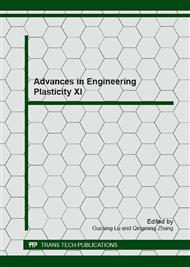p.275
p.279
p.284
p.288
p.292
p.296
p.300
p.306
p.310
Forming Limit of AZ31 Magnesium Alloy Sheet under Non-Proportional Deformation at Elevated Temperature
Abstract:
In the present work, FLDs of AZ31 magnesium alloy sheet for non-proportional strain paths were investigated by performing two-step stretch forming experiments at various forming speeds (3, 30 and 300 mm.min-1) at elevated temperatures of 150, 200 and 250°C. The forming limit strains, both for proportional and non-proportional deformations, increased with temperature rise and with decreasing forming speed. A FLC after a uniaxial pre-strain lies outside of the proportional FLC for a given condition of temperature and forming speed, whereas a biaxially pre-strained FLC lies inside of the proportional FLC. It was found that the accumulated effective plastic strain and the direction of plastic strain increment at the final stage of forming are two major factors that influence the forming limits for non-proportional deformations.
Info:
Periodical:
Pages:
292-295
Citation:
Online since:
January 2013
Authors:
Price:
Сopyright:
© 2013 Trans Tech Publications Ltd. All Rights Reserved
Share:
Citation:


